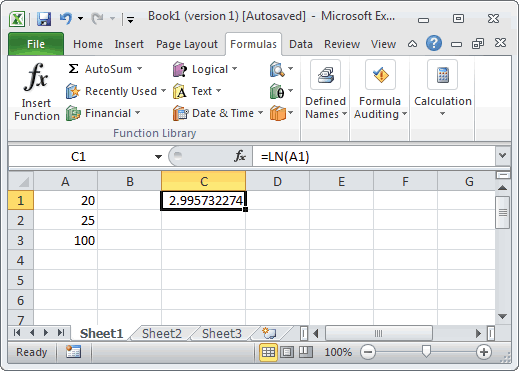In this lesson I remind you what is logarithm. You will also get to know how to calculate logarithm, common logarithm, natural logarithm, inverse logarithm and inverse natural logarithm in Excel.
- Natural Log In Excel 2010
- Natural Log Regression In Excel
- Base Of Natural Log In Excel
- Natural Log In Excel Formula
- Finding Natural Log In Excel
- Natural Log
'ln' stands for natural logarithm; A natural logarithm is just a logarithm with a base of 'e' 'e' is the natural base and is approximately equal to 2.718; y = b x is in exponential form and x = log b y is in logarithmic form; The definition of logarithms says that these two equations are equivalent, so we can convert back and forth between them. In this article, we will learn about how to use the LN function in Excel. In mathematics ln is an inverse of an exponential function. The logarithm to base e (value of e is approximately equals to 2.7128) is called the natural logarithm. E x = y x = log e (y) The LN function returns the log of a value at base e. For example log(e) at base e returns 1.
This tutorial shows how to create a log-log plot for two variables in Excel. Example: Log-Log Plot in Excel. Suppose we have the following dataset in Excel that shows the values for two variables, x and y: Use the following steps to create a log-log plot for this dataset: Step 1: Create a scatterplot. Highlight the data in the range A2:B11. In this article, we will learn about how to use the LN function in Excel. In mathematics ln is an inverse of an exponential function. The logarithm to base e (value of e is approximately equals to 2.7128) is called the natural logarithm. Subscribe Now:More:the inverse log function in Excel i.
Let's start from the theory.
What is logarithm?
The easiest way to understand what logarithms are is to understand this mathematical formula:
Loga b=c ac=b
For example
Log2 3 = 8 because 23=8
What is common logarithm?
Common logarithm is just logarithm with base 10. You don't need to write 10 as a base Log10 x = log x
For example:
log 1 = 0
log 10 = 1
log 1000 = 3
What is natural logarithm?
Natural logarithm is a special kind of a logarithm. Natural logarithm is a logarithm to the base e. e is mathematical constant which is is approximately equal to 2.718281828459. Instead of loge x we use ln x
Microsoft Excel has built-in functions to calculate the logarithm of a number with a specified base, the logarithm with base 10, and the natural logarithm. To calculate the inverse log of a number in the first two cases, raise the base to the power of the value returned by the particular logarithm function being used. To find the inverse natural log, use the EXP function.
Natural Log In Excel 2010
How to calculate logarithm and inverse of logarithm?
To calculate logarithm in Excel just use LOG function.
=LOG(n,b)
n = number
b = base
=LOG(16,4) – result is 2
=LOG(81,9) – result is 2
=LOG(125,5) = result is 3
=LOG(512,2) – result is 9
To calculate an inverse of logarithm use power function
=POWER(base, result) – watch out not to change the sequence!
Natural Log Regression In Excel
=POWER(4, 2) – equals 16
=POWER(9, 2) – equals 81
=POWER(5, 3) – equals 125
=POWER(2, 9) – equals 512
How to calculate common logarithm and inverse of common logarithm?

To calculate logarithm in Excel just use LOG function.
=LOG10(n)
n = number
Base of common logarithm is always 10.
=LOG10(100) – result is 2
=LOG10(1) – result is 0
=LOG10(1000) = result is 3
=LOG10(0.0000001) – result is -7
To calculate an inverse of common logarithm use power function
=POWER(10, result) – always 10 because this is the base of common logarithm
=POWER(10, 2) – equals 100
=POWER(10, 0) – equals 1
=POWER(10, 3) – equals 10
=POWER(10, -7) – equals 0.0000001
How to calculate natural logarithm and inverse of natural logarithm?
To calculate natural logarithm in Excel just use LN function.
=LN(n)
n = number
Base of natural logarithm is always e
=LN(1) – result is 0
=LN(2.718281828) – result is 1
Base Of Natural Log In Excel
=LN(10) = result is 2.30258509
=LN(100) – result is 4.60517019
Natural Log In Excel Formula
To calculate an inverse of natural logarithm use EXP function
=EXP(n)
n = number
Finding Natural Log In Excel
=EXP(0) – equals 1
=EXP(1) – equals 2.718281828
=EXP(2.30258509) – equals 10
Natural Log
=EXP(4.60517019) – equals 100
Comments are closed.